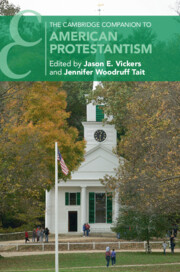Book contents
- The Cambridge Companion to American Protestantism
- Cambridge Companions to Religion
- The Cambridge Companion to American Protestantism
- Copyright page
- Dedication
- Contents
- Contributors
- Acknowledgments
- Introduction
- Part I Historical Overview
- Part II The Religious Culture of American Protestantism
- Part III Theological Traditions
- 17 Anglicanism
- 18 The Reformed Tradition
- 19 The Lutheran Tradition
- 20 Brethren and Mennonite Traditions
- 21 Baptists
- 22 The Stone-Campbell Movement
- 23 Wesleyan-Methodist and Holiness Traditions
- 24 Pentecostalism
- Selected Bibliography
- Index
- Cambridge Companions to Religion (continued from page ii)
23 - Wesleyan-Methodist and Holiness Traditions
from Part III - Theological Traditions
Published online by Cambridge University Press: 11 May 2022
- The Cambridge Companion to American Protestantism
- Cambridge Companions to Religion
- The Cambridge Companion to American Protestantism
- Copyright page
- Dedication
- Contents
- Contributors
- Acknowledgments
- Introduction
- Part I Historical Overview
- Part II The Religious Culture of American Protestantism
- Part III Theological Traditions
- 17 Anglicanism
- 18 The Reformed Tradition
- 19 The Lutheran Tradition
- 20 Brethren and Mennonite Traditions
- 21 Baptists
- 22 The Stone-Campbell Movement
- 23 Wesleyan-Methodist and Holiness Traditions
- 24 Pentecostalism
- Selected Bibliography
- Index
- Cambridge Companions to Religion (continued from page ii)
Summary
Methodism – the Christian tradition that traces its heritage to John Wesley – became the largest religious group in the United States by the 1840s. Its rapid growth began during the early years of the American republic and extended throughout the decades of the nineteenth century. The Methodist tradition as a whole remained the largest expression of American Protestant Christianity from the 1840s to the 1920s; religious historians refer to the 1800s as “the Methodist age in America.” The Wesleyan family of Methodist and Holiness churches has remained the third largest religious group of denominations and the second largest Protestant tradition in America throughout the twentieth and early twenty-first centuries. Owing to the breadth of geography, ethnicity, and social class that characterizes Methodism’s demographic spread, historians and sociologists often view Methodism as the quintessential example of American religious identity.
- Type
- Chapter
- Information
- The Cambridge Companion to American Protestantism , pp. 435 - 460Publisher: Cambridge University PressPrint publication year: 2022

